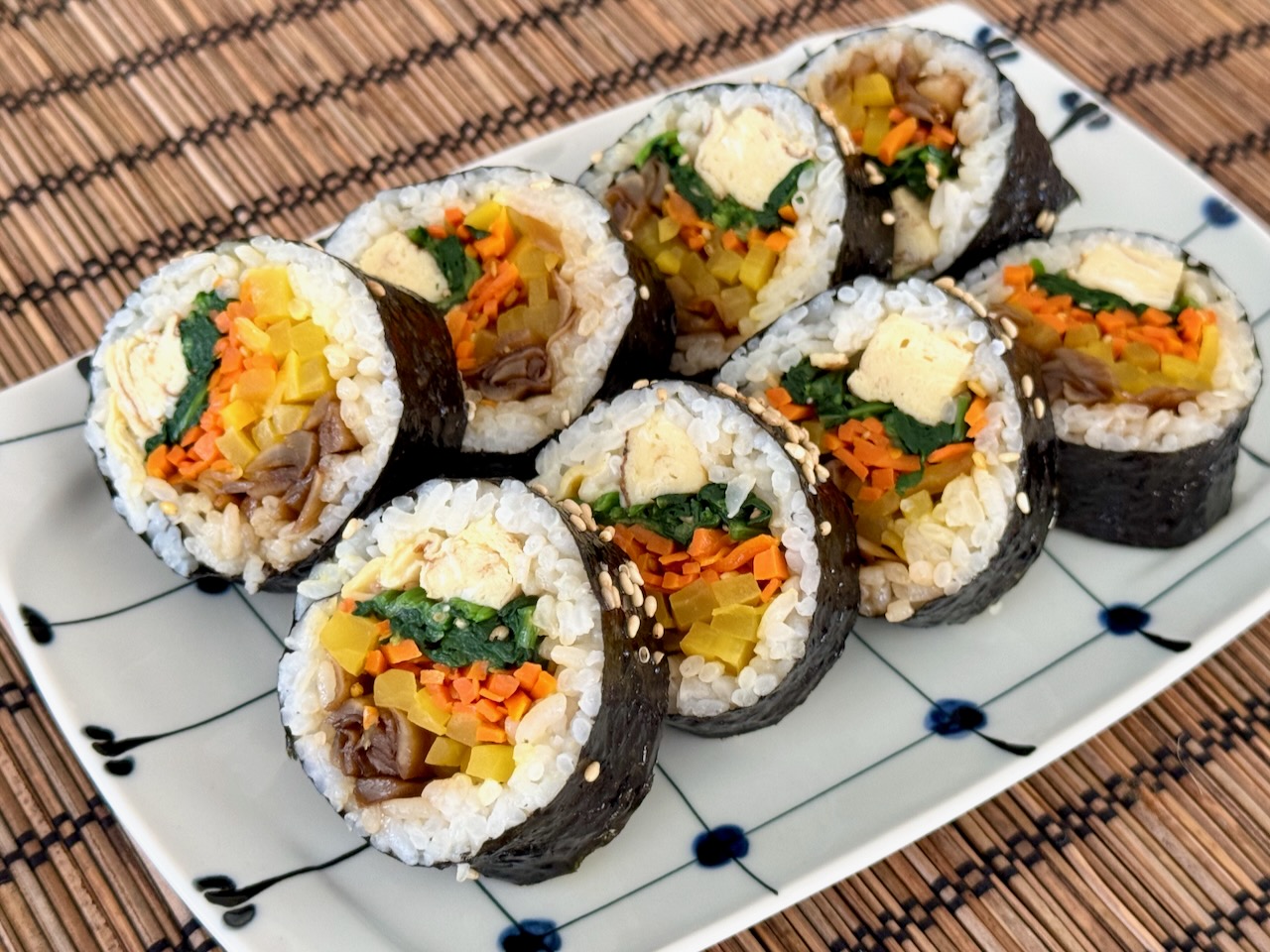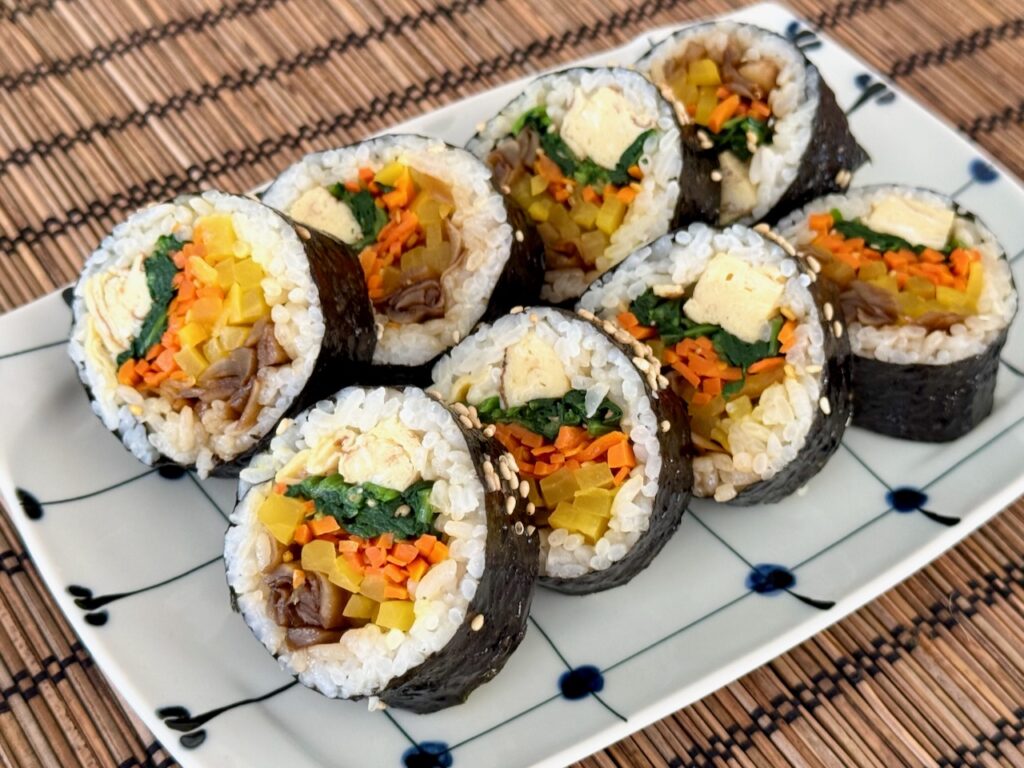Kimbap is a Korean version of Futomaki or Norimaki, a kind of sushi roll with a variety of fillings such as vegetables and cooked meat or seafood wrapped in roasted Nori seaweed. It is much thicker than single-ingredient rolls like Tuna rolls or cucumber rolls, and the fillings for Kimbap are cooked and flavored individually. Kimbap is becoming increasingly popular in Japan in recent years, sold at convenience stores and even Kimbap specialty stores in large Japanese cities. The more kinds of fillings used, the more work it takes to make, but it’s worthwhile to have a variety of vegetables and meat to enjoy interesting harmony of different flavors.
Kimbap is technically not sushi because its rice is often seasoned with salt and sesame oil rather than vinegar. Typical fillings include seasoned beef, cooked vegetables such as carrot and spinach, Kimchi, and other ingredients. There are also creative additions that surprisingly taste well in the roll, such as cheese and sausage. Kimbap is heavily flavored with sesame oil and sesame seeds, which distinguishes it from Japanese Futomaki rolls.
Our Kimbap here may not be exactly authentic Korean Kimbap, but rather has a Japanese twist using sweet and salty burdock and Tamagoyaki (rolled egg) as fillings. Each vegetable is cooked and flavored individually to simulate original Kimbap, which some may find tedious to make. If that’s the case, you may want to use other vegetables that can be used raw, like cucumbers, to omit cooking. However, having many ingredients with different flavors makes the dish definitely more interesting and tasty. We promise your hard work will pay off in the end. Also, fillings can be prepared ahead. Make some of them a day before, and roll up with rice just before serving. We hope you give it a try!

Kimbap
Ingredients
- 2 inches Takuan, pickled yellow radish
- 2 sheets Nori roasted seaweed (8" square (20 cm))
- 2 tsp sesame oil
- 2 tsp sesame seeds
Seasoned Rice
- 2 cups steamed rice
- 1/4 tsp salt
- 1/2 Tbsp sesame oil
Cooked Burdock
- 9 inches burdock
- 1 tsp sesame oil
- 1 Tbsp sugar
- 1 Tbsp soy sauce
- 1/2 Tbsp mirin
- 2 Tbsp water
Cooked Carrot
- 1 carrot (small)
- 1/2 Tbsp sesame oil
- 1/8 tsp salt
- 1 tsp sesame seeds
Cooked Spinach
- 1/2 bunch spinach
- 1 tsp soy sauce
- 1 tsp sugar
- 1/8 tsp salt
- 1 tsp sesame oil
- 1 tsp sesame seeds
Instructions
- Cut Takuan pickled yellow radish into thin matchsticks. Set aside.
- Make seasoned rice. Put steamed rice in a bowl, and season with salt and sesame oil. Cover and set aside.
- Make cooked burdock. Cut the burdock root into thin strips. In a medium pot or frying pan, heat sesame oil, add burdock, and stir-fry for 2-3 minutes. Add the rest of the ingredients, cover, and cook at medium low heat until the liquid is almost gone. Set aside.
- Make cooked carrot. Peel and cut carrot into thin matchsticks. In a frying pan, heat oil at medium heat, add carrot, and cook until carrot is tender. Add salt and sesame seeds, and stir. Set aside.
- Make cooked spinach. In a boiling water, cook spinach for 30 seconds or so. Strain and let cool. Once it's cooled, squeeze out water very well. Cut into 1" (2.5 cm) length. In a medium bowl, add the rest of the ingredients, and mix with the cut spinach.
- Make Tamagoyaki rolled egg. Beat eggs and seasonings together in a bowl. Heat a rectangular pan over medium-high heat and add oil. Pour a thin layer of egg mixture in the pan, tilting to cover the bottom. After the thin egg has set a little, gently roll into a log. Repeat adding egg to the pan and rolling back and forth until all the egg mixture is used. Refer to our Tamagoyaki recipe for guidance. When cooled, cut Tamagoyaki into thin, long strips, about 8" long and 1/2" thick (20 cm x 1 cm).
- Assemble. Place a sushi mat flat on your work surface with the bamboo slats running left to right, so you can roll the mat away from you. Place a piece of seaweed on the sushi mat with one of the seaweed's sides close to the front edge of the mat (the edge near you). Spread about 1 cup of the seasoned rice on the seaweed, leaving a 1" (2.5 cm) space at the far edge. Horizontally place Takuan, burdock, carrot, spinach, and Tamagoyaki next to each other in the middle of the rice. Holding the filling down, roll from the front end of the mat toward the other end. Tighten the roll like a jelly roll, pulling the mat to compress. Remove the roll from the mat. Repeat to make another roll.
- Brush the surface of the rolls with sesame oil, and sprinkle with sesame seeds. Cut the rolls into 3/4-inch (2 cm) thick slices.
Video


